Yes, manta rays (members of the family Myliobatidae) have paired fins. The fact is they have three functional pairs of fins, including the pectoral fin, pelvic fin, and cephalic fin.
These fins are used for stability and maneuverability, controlling speed and direction of movement, and maintaining balance. The attributes of these fins might look easy, but trust us, they are more challenging than they seem.
This article will tell you everything about manta ray fins that you have ever wondered about.
Do Manta Rays Have Wings or Fins? How Many?
Manta rays have fins, not wings. They have large pectoral fins, which they use to maneuver and control their movement in the water. The pectoral fins resemble wings, which led to the species being named “manta,” meaning cloak or mantle in Spanish.
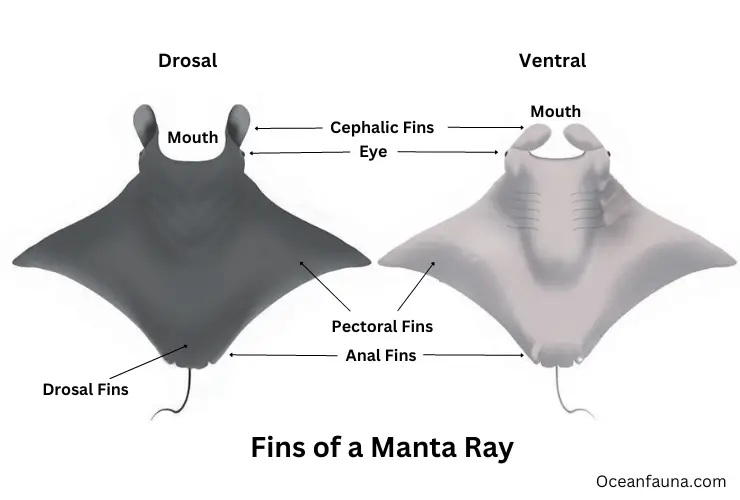
Manta rays have a total of 6 fins, with three pairs of fins each. These fins near the back of the manta ray’s body are used for propulsion and stability. Unlike other species, manta rays do not have a stinging spine.
Instead, they have smooth, streamlined body that allows them to glide gracefully through the water.
Different Sizes of Fins on Different Types of Manta Rays
The size of a manta ray’s fins can vary based on the species and the individual animal. For example, the wingspan of a reef manta ray (Manta alfredi) can range from 4 to 5.5 meters.
On the other hand, the wingspan of a giant oceanic manta ray (Manta birostris) can reach up to 7 meters. The size of the fins also depends on factors such as age, sex, and health of the individual.
Male manta rays generally tend to have smaller fins than female manta rays. This may be due to differences in the physiological demands of reproduction between males and females (other factors such as the size of their habitat and food availability).
Additionally, manta rays living in different parts of the ocean may have fins adapted to their specific environment.
For example, manta rays that live in areas with strong currents and rough waters may have larger fins to help them maneuver and maintain stability in these conditions.
So to put it all together, the size of a manta ray’s fins can vary based on species, individual, age, sex, and habitat, among other factors.
These differences in size and shape reflect the remarkable adaptability of these magnificent creatures to their environment and the demands of survival in the ocean.
Do Manta Rays Have Dorsal Fins?
Yes, manta rays have a dorsal fin. They have a triangular-shaped dorsal fin located on their backs, near the middle of their bodies. The dorsal fin is a defining feature of manta rays and helps stabilize them while swimming.
The shape and size of the dorsal fin can vary between individuals and is used as a way to identify specific manta rays. Researchers have found that the shape of the dorsal fin is unique to each individual, much like a fingerprint, making it a useful tool for studying populations of manta rays.
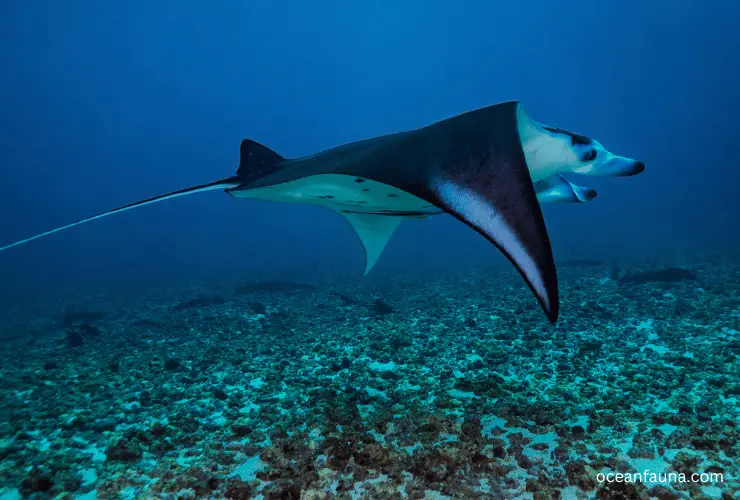
The dorsal fin is also important for controlling the direction and speed of the manta ray. The manta ray can change the position of its dorsal fin to alter its swimming speed, allowing it to move through the water more efficiently.
What Can Cause Damage to Manta Ray Fins? 5 Most Common Causes
Various factors, including human activities, environmental factors, and disease, can damage manta rays’ fins. Some of the most common causes of fin damage include:
- Fishing: Manta rays can be accidentally caught in fishing gear, such as gillnets, longlines, and trawls. This can cause damage or amputation of their fins, reducing mobility and increasing vulnerability to predation.
- Pollution: Exposure to pollution, such as oil spills and plastic debris, can cause damage to manta rays’ fins and skin. The accumulation of toxic chemicals in the fins can damage tissue, reducing their ability to function effectively.
- Climate change: Changes in water temperature and acidity caused by climate change can harm manta rays and cause damage to their fins. Warmer waters can increase the growth of harmful algae and parasites, while more acidic waters can erode the fins and make them more susceptible to disease.
- Disease: Manta rays can be affected by various diseases, including skin infections, parasitic infections, and tumors, which can cause damage to their fins. These conditions can sometimes result from exposure to ocean pollutants and pathogens.
- Boat strikes: Collisions with boats can cause serious injuries to manta rays, including fin damage. This is particularly a concern in areas with a high density of boat traffic and limited regulations to protect these animals.
These threats can seriously impact the health and survival of these magnificent creatures. Protecting them and their habitats is important to ensure their long-term survival.
Do Manta Rays Have Pectoral Fins?
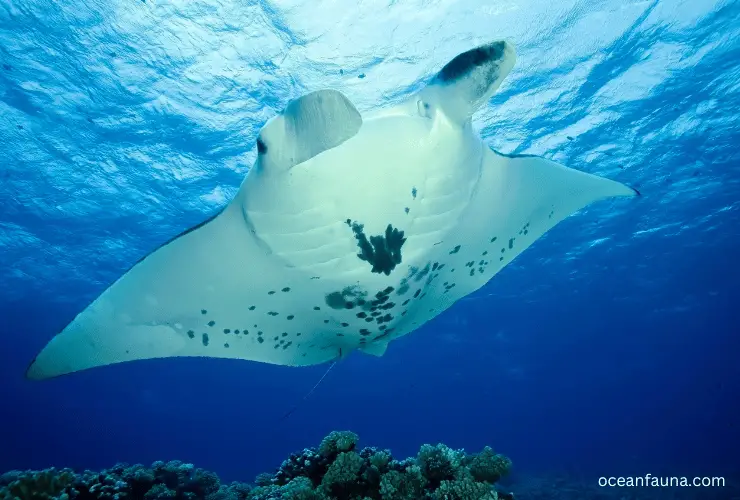
Yes! Manta Rays do have pectoral fins. The pectoral fins on a manta ray are essential for its survival in the ocean. These fins are used for both propulsion and maneuverability.
The manta ray uses its pectoral fins for the following reasons:
- Swim through the water
- Change directions, and
- Maintain stability.
The fins also play a crucial role in allowing the manta ray to execute sharp turns and avoid predators.
Additionally, the pectoral fins are used in courtship displays, which are important for mating and reproducing. The fins’ size and shape vary among species, reflecting their specialized functions and environmental adaptations.
The pectoral fins are critical for the manta ray’s survival and success in its underwater habitat.
Different Uses of Manta Ray Fins
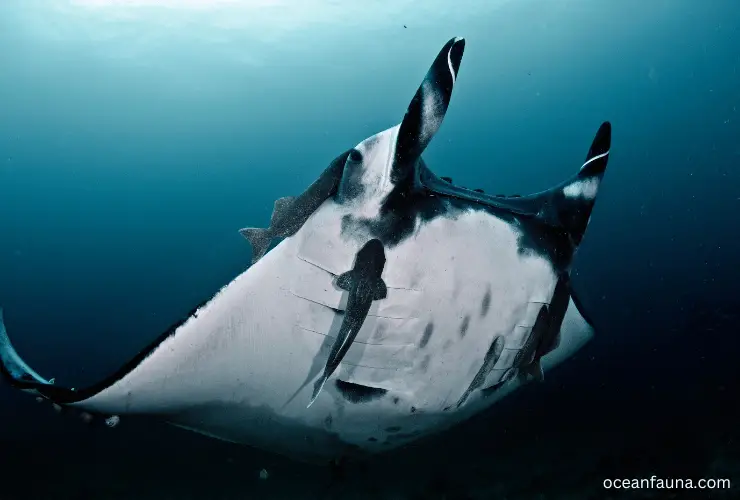
The three pairs of fins on a Manta Ray each have different uses, like feeding, stability, and propulsion, but maneuverability is one common function of all these pairs.
Here are the different uses of different pairs of fins:
Cephalic Fin Pair
The cephalic fins, also known as the “head fins” of a manta ray and are an anterior subdivision of the pectoral fin, serve several important functions.
- Feeding: The cephalic fins are used to direct water into the manta ray’s mouth while feeding on plankton and small fish. This allows the manta ray to filter its food from the water efficiently.
- Maneuverability: The cephalic fins aid in maneuverability and stability during turns, making it easier for the manta ray to change direction quickly.
- Communication: Some research suggests that cephalic fins may also play a role in communication and social behavior. Manta rays are known for their complex social interactions, and the cephalic fins may be used as part of a visual signaling system.
Pelvic Fin Pair
The pelvic fins of a manta ray serve several important functions, including stability and balance while swimming and hovering.
- Stability: The pelvic fins help the manta ray to maintain balance and stability while swimming, especially when making sudden changes in direction or hovering in place.
- Buoyancy control: The pelvic fins also play a role in buoyancy control, allowing the manta ray to adjust its position in the water column and regulate its depth.
- Maneuverability: The pelvic fins can also be used for maneuverability, with precise movements allowing the manta ray to make subtle adjustments to its course.
Pectoral Fin Pair
The pectoral fins of a manta ray serve several important functions, including propulsion and maneuverability.
- Propulsion: The pectoral fins generate forward thrust, with rhythmic flapping helping the manta ray move through the water. These fins provide a significant portion of the manta ray’s forward movement.
- Maneuverability: The pectoral fins are also used for maneuverability and can be flapped in different ways to make sharp turns and sudden stops. This allows the manta ray to navigate through its environment with precision and agility.
- Stability: The pectoral fins also play a role in stability, helping the manta ray to maintain balance while swimming and hovering.
Their large size and unique design make them essential for the manta ray’s ability to move through the water and navigate its environment efficiently.
Manta Ray Fins vs. Sting Ray Fins
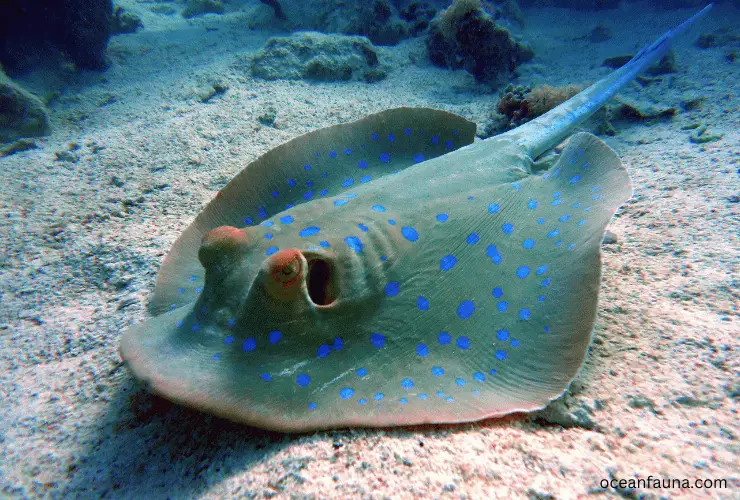
Manta rays and stingrays are both members of the ray family, but their fins have some key differences.
- Shape: Manta rays have large, broad pectoral fins that are used for propulsion and maneuverability, while stingrays have smaller, more triangular pectoral fins that are used for stability and propulsion.
- Location: Manta rays have a small dorsal fin located near the tail, while stingrays lack a dorsal fin. Instead, they have a long, whip-like tail that is used for propulsion and defense.
- Function: Manta rays use their cephalic fins to direct water into the mouth for feeding and to aid in maneuverability, while stingrays lack cephalic fins.
Stingrays use their large pectoral fins to generate forward thrust and maintain stability while swimming, while their tail is used for propulsion and defense.
While manta and stingrays belong to the ray family, their fins serve different functions and are shaped differently to accommodate their unique lifestyles.
Manta Ray Fins vs. Skate Fins
Manta Ray fins are characterized by their large blade size and soft, flexible material. This provides excellent propulsion and maneuverability underwater. They are also designed to minimize stress on the legs and feet, making them ideal for long swims or dives.
On the other hand, Skate fins are designed for quick acceleration and high speed. They have a smaller blade and a stiffer material, allowing for a more powerful kick.
Skate fins are often used in activities such as bodysurfing and wave riding, where a sudden burst of speed is necessary.
Regarding sizing, Manta Ray fins tend to fit larger and wider feet, whereas Skate fins are more suited for smaller and narrower feet. Manta Ray fins are also generally heavier and bulkier than Skate fins, making them less suitable for travel and storage.
FAQs
Are Manta Rays an Endangered Fish?
Yes, Manta Rays are endangered. The International Union for Conservation of Nature (IUCN) lists the reef manta ray and the giant manta ray as vulnerable species, facing a high risk of extinction in the wild.
Populations have declined in many regions, particularly in Southeast Asia and the Western Atlantic. In response, some countries have implemented protective measures such as fishing bans and the creation of manta ray sanctuary areas.
Still, more actions are needed to ensure their long-term survival.
Are Manta Rays Evil?
No, manta rays are not evil. They are gentle, harmless creatures that play important roles in their marine ecosystems as predators and prey.
Manta rays do not threaten humans; interactions with them can be a valuable and unique experience for divers and snorkelers.
Any negative perceptions of manta rays may stem from misconceptions or a lack of understanding about these magnificent animals.
How Long Do Manta Rays Live For?
Manta rays can live for up to 40 years in the wild. The lifespan of manta rays can vary depending on various factors such as species, location, and environmental conditions.
Conclusion
Like most species of sharks and rays, manta rays are believed to sleep while swimming. Unlike terrestrial animals that can fall into a deep sleep while lying still, manta rays must continuously swim in order to maintain their oxygen supply and avoid sinking.
The exact process by which manta rays sleep while swimming is not well understood, but studies suggest that they reduce their activity levels and swim in a more predictable, repetitive pattern during rest periods.

3 thoughts on “Do Manta Rays Have Paired Fins? [All About Fins]”